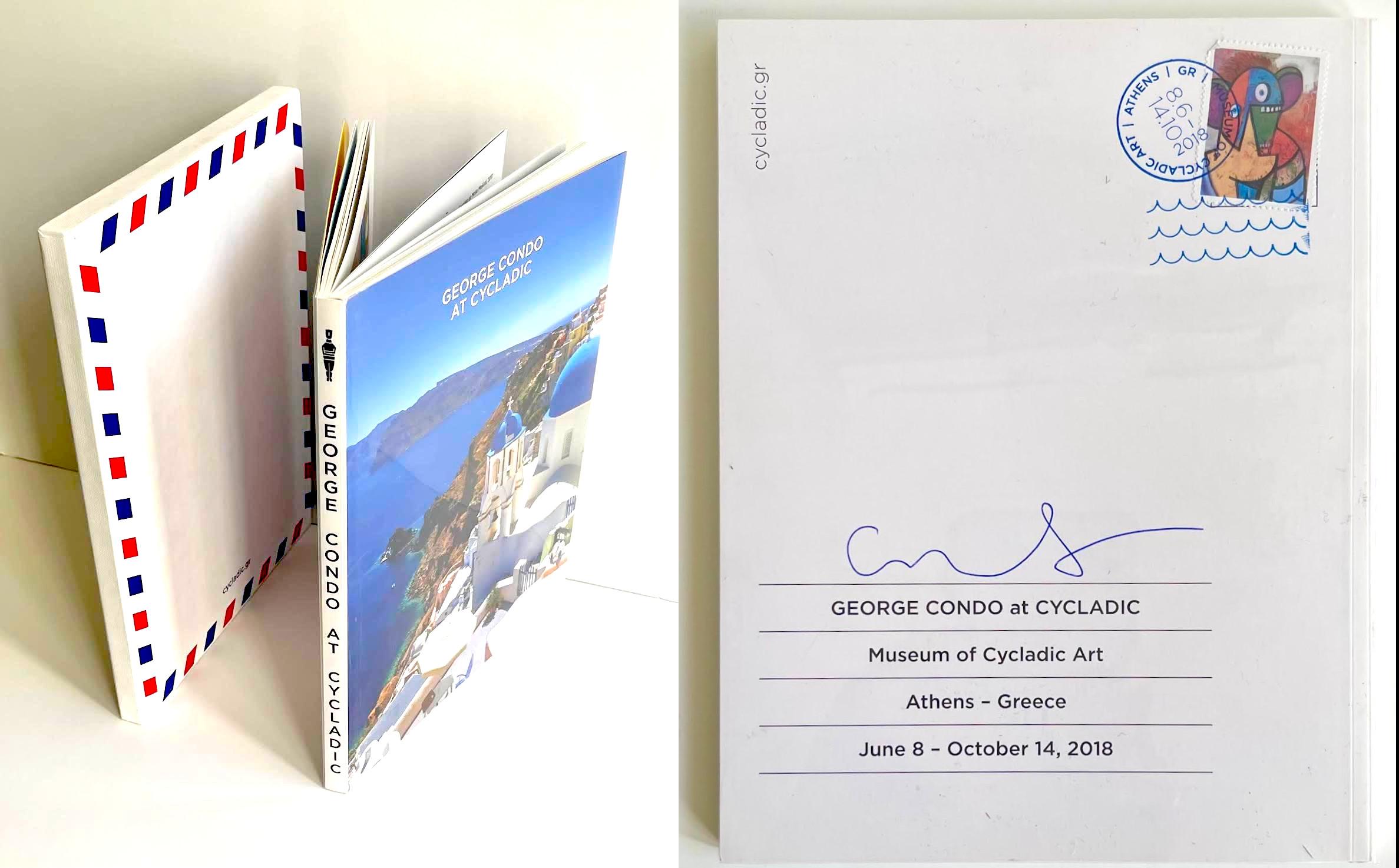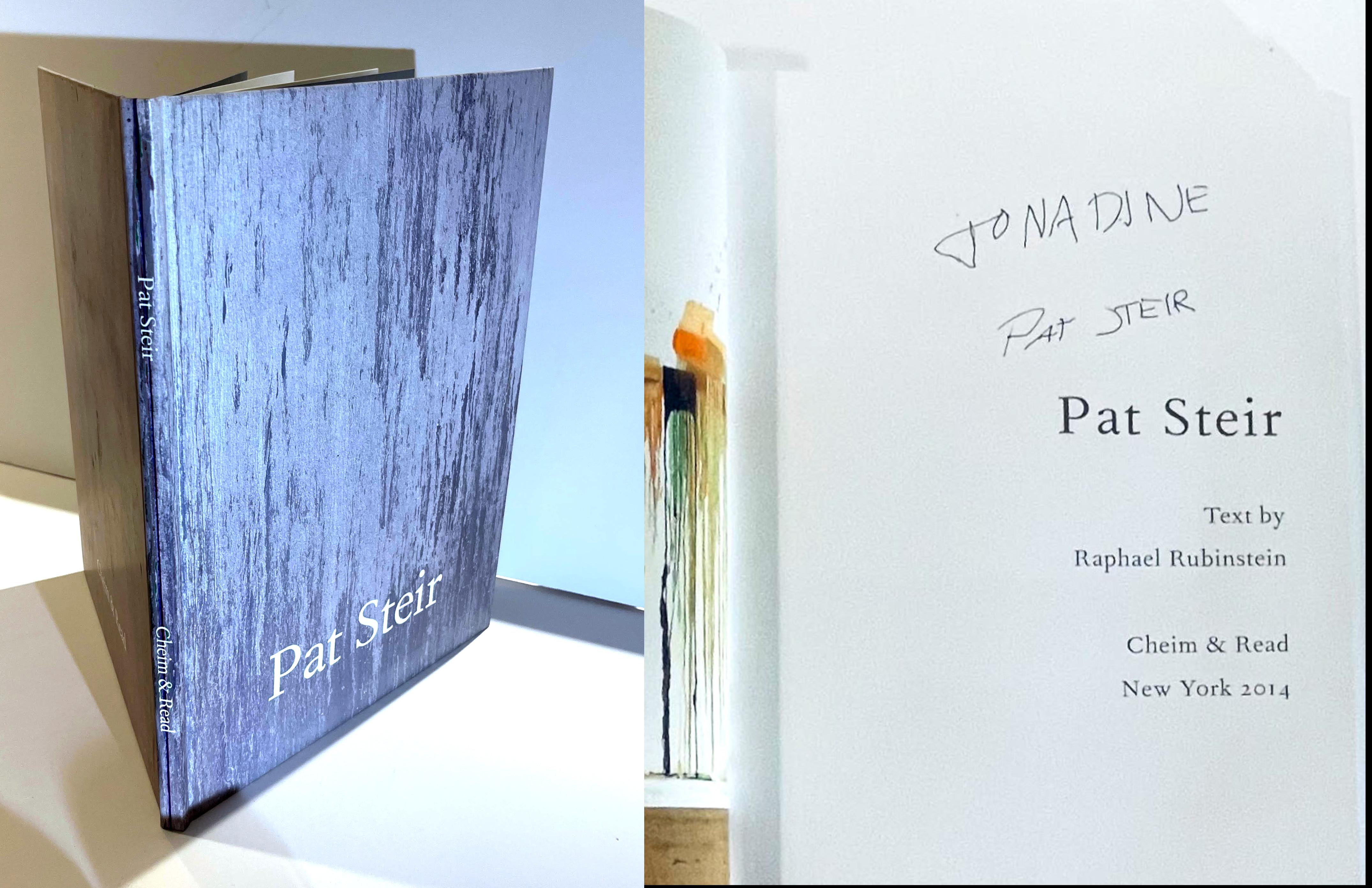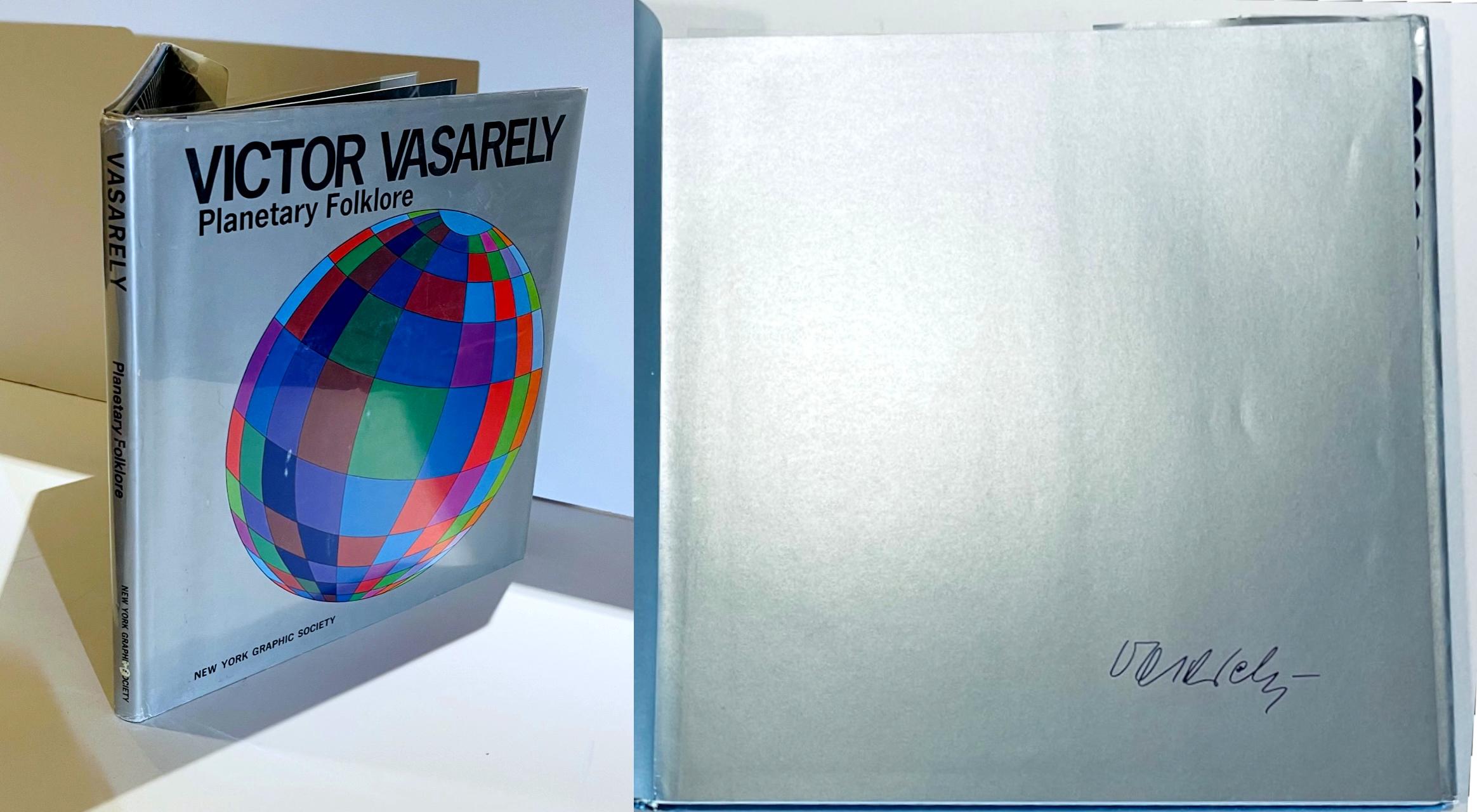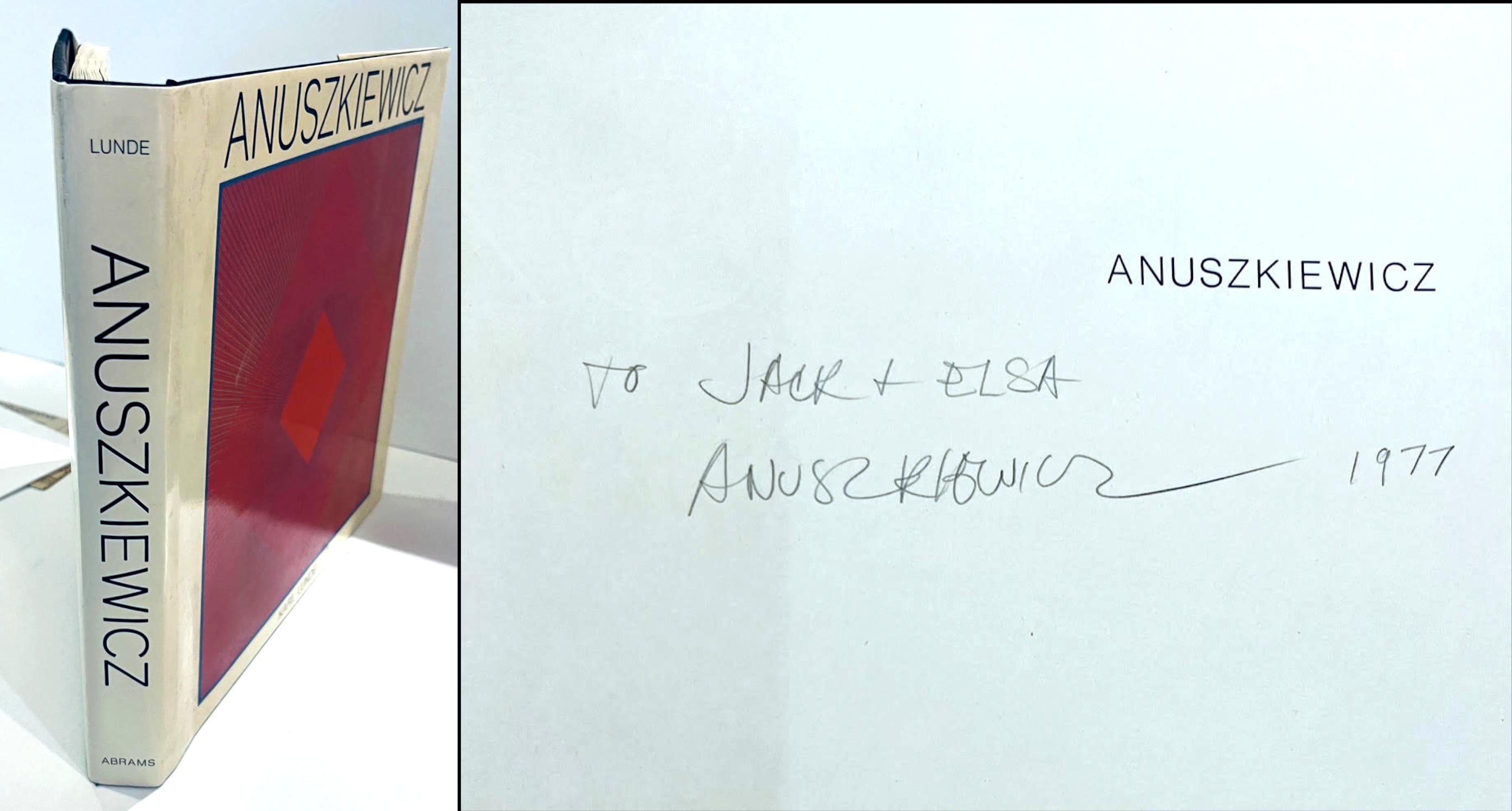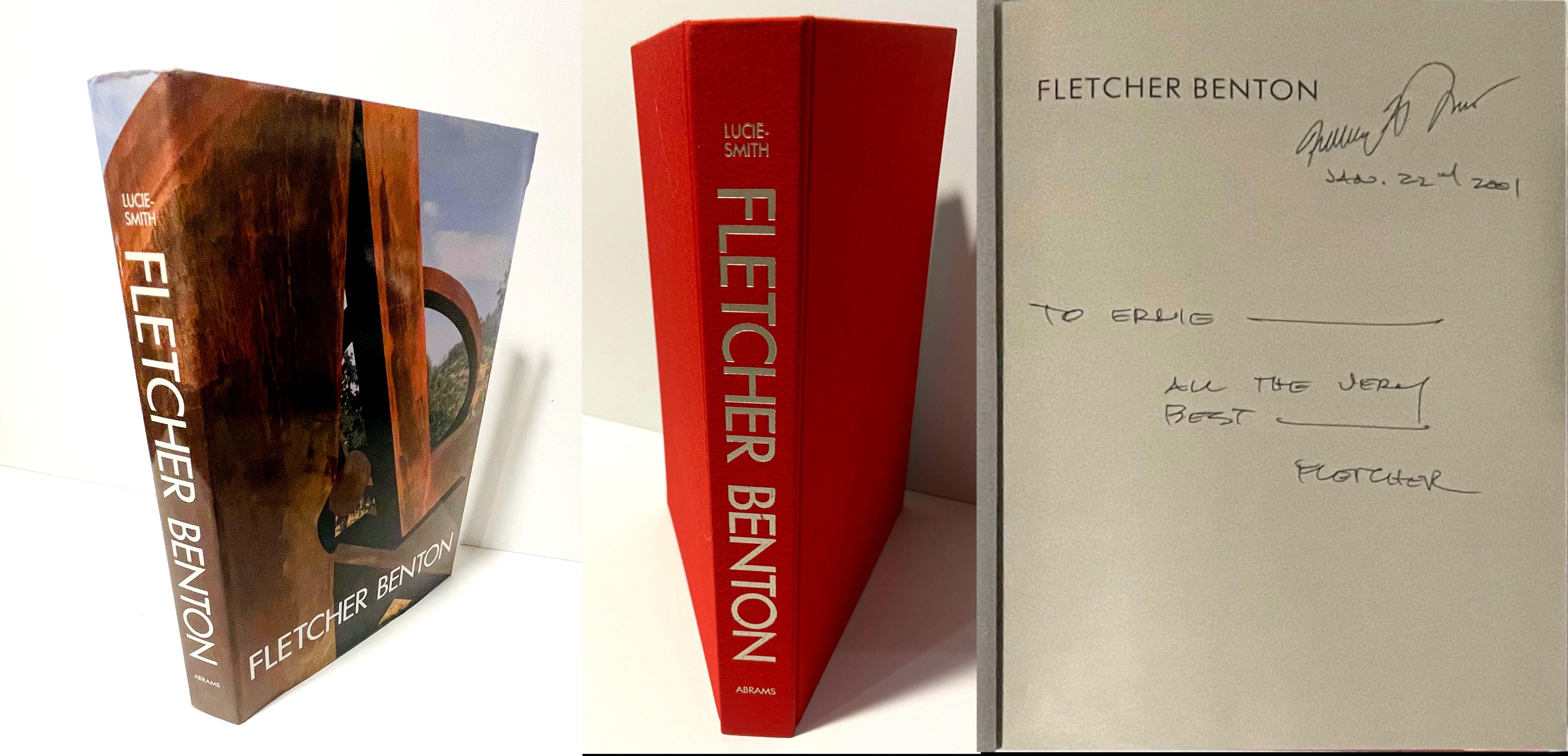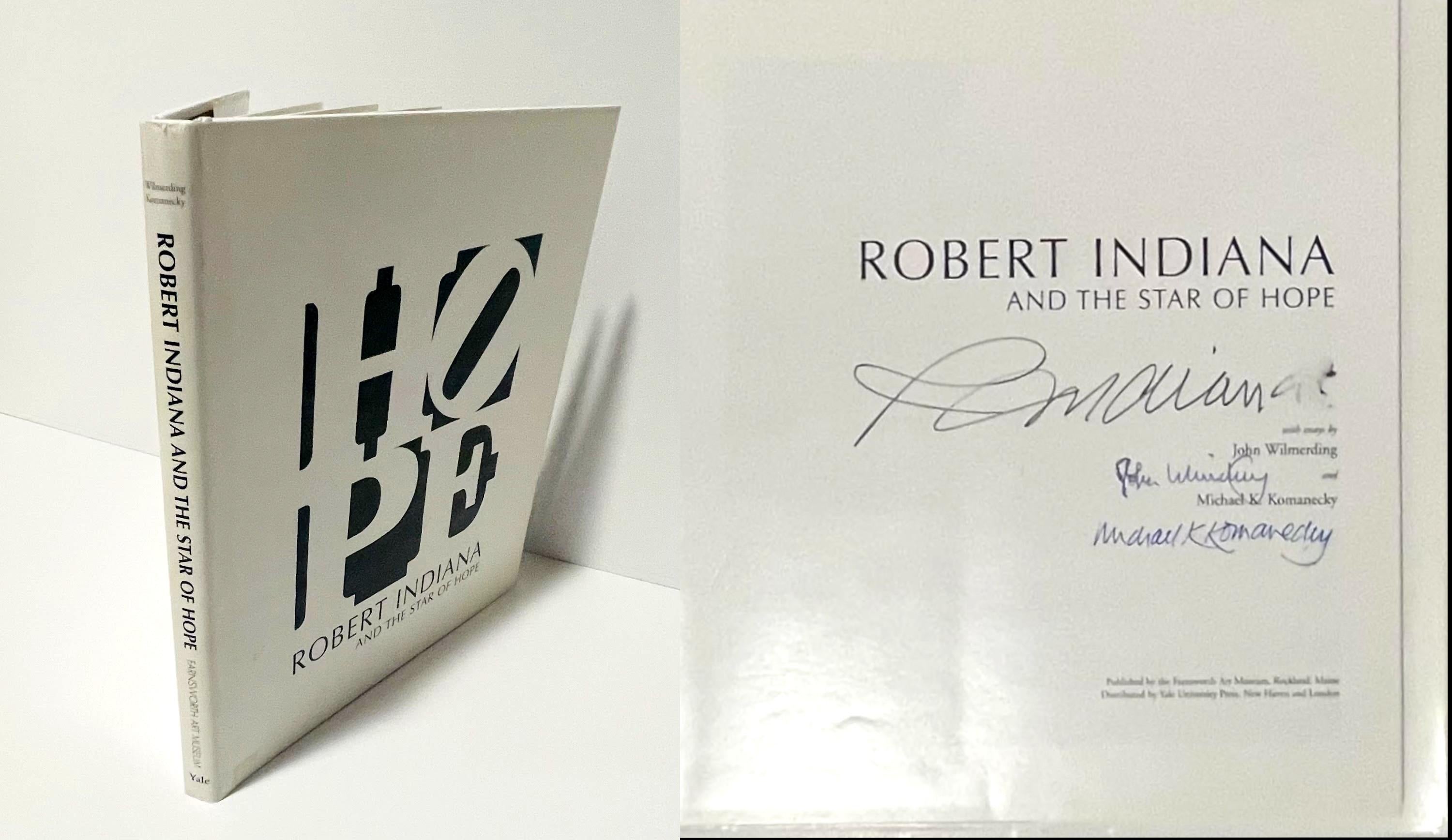Items Similar to Do Not Abandon Me (Hand signed in green marker by Tracey Emin)
Want more images or videos?
Request additional images or videos from the seller
1 of 19
Louise Bourgeois & Tracey EminDo Not Abandon Me (Hand signed in green marker by Tracey Emin)2010
2010
About the Item
Louise Bourgeois & Tracey Emin
Do Not Abandon Me (Hand signed in green marker on the half title page by Tracey Emin), 2010
Cloth hardback monograph with no dust jacket as issued (Hand signed in green marker on the half title page by Tracey Emin)
Limited Edition of 1500 (this is exceptionally hand signed; the regular edition is unsigned)
Hand signed in green marker on the half title page by Tracey Emin
14 1/4 × 12 1/4 × 1/2 inches
This elegant, highly collectible limited edition monograph with cloth boards and no dust jacket, as issued, was published in a stated limited edition of 1500 (the regular edition was unsigned) to accompany the exhibition "Louise Bourgeois and Tracey Emin Do Not Abandon Me" by Carolina Nitsch, NY, September 10 to October 23, 2010 and Hauser & Wirth, London, February 18 to March 22, 2011.
Hand signed in green marker on the half title page by Tracey Emin.
Makes a superb gift!
Book information:
Publisher: Hauser & Wirth Publishers / Carolina Nitsch (September 2010)
English; Clothbound hardcover; 42 pages with color illustrations
Publisher's blurb:
Do Not Abandon Me', a collaboration between Louise Bourgeois and Tracey Emin, consists of sixteen intimate works made between 2008 and 2010.
About Tracey Emin:
Self-portraiture and the nude run throughout her practice, which Emin has described as being about ‘rites of passage, of time and age, and the simple realisation that we are always alone’. Her earliest works refer to her family, childhood and chaotic teenage years, growing up in the seaside town of Margate and leaving home at the age of fifteen. What happened next is explored, in a manner that is neither tragic nor sentimental, in drawing, painting, film, photography, sewn appliqué, sculpture, neon and writing, as the vicissitudes of relationships, pregnancies and abortions intersect with her commitment to the formal disciplines of art. Most recently, the artist has experienced her body as a battleground, through illness and ageing, on which she reports with characteristic fearlessness.
The playful title of Emin’s first solo exhibition, My Major Retrospective 1963–1993, suggests the artist felt, despite being at the beginning of her career, significant things had already happened. Her obsessive assemblage of personal memorabilia included tiny photographs of her art school paintings that she’d destroyed, a ‘photographic graveyard’ that revealed an admiration for paintings by Egon Schiele and Edvard Munch. She details this ‘emotional suiside’ in Tracey Emin’s CV Cunt Vernacular (1997), among several early video works that give further insight into her formation as an artist, highlighting moments of epiphany through the use of first-person narrative. ‘I realised there was the essence of creativity, that moment of conception,’ she says in How It Feels (1996), a pivotal film in which she tells the story of her abortion. ‘The whole being of everything… it had to be about where it was really coming from’. Speaking to camera while walking through the streets of London, she concludes that conceptual art, as an act of reproduction, is inseparable from the artist’s inner life. Developing this connection, the haunting film Homage to Edvard Munch and All My Dead Children (1998) shows the artist on the pier near Munch’s house, naked and prostrate in the foetal position, the dawn rising over the water as she lifts her head and screams – a guttural response to great painter’s iconic image.
In 1998, Emin created My Bed, an uncensored presentation of her most personal habitat. The double bed has become abstracted from function as it sits on the gallery floor, in conversation with art history and a stage for life events: birth, sleep, sex, depression, illness, death. The accumulation of real objects (slippers, condoms, cigarettes, empty bottles, underwear) on and around the unmade bed builds a portrait of the artist with bracing matter-of-factness, defying convention to exhibit what most people would keep private. The work gained international attention as part of the Turner Prize, entering Emin into public consciousness. Another work that became a byword for her art of disclosure was the sculpture Everyone I Have Ever Slept With 1963−1995 (1995, destroyed 2004), where the names of all those she had ever shared a bed with – friends, lovers and family – were sewn on the inside of a tent, a crawl-space that invites the viewer to reflect on their own inventory.
Explicitly feminist, and acknowledging the influence of her friend and collaborator Louise Bourgeois, Emin’s choice of medium is integral to the story she tells. In hand-embroidered blankets and quilts, traditionally associated with women’s work, she pierces the visual field with words, combining scraps of different material with uneven stitching to spell out statements whose syntax and spelling remain uncorrected. With titles such as Mad Tracey from Margate. Everyone’s been there, (1997) or Helter Fucking Skelter (2001), they register the artist’s acute sensitivity to the views of those around her and give a riposte, just as the medium is a riposte to the classification of fine art, for centuries dominated by male artists. As she herself became newsworthy, both nationally and internationally, Emin used the publicity to prick other forms of decorum in the professional art world – such as never over-explaining. In longer form, her memoir, Strangeland (2005) offers an account of her journey to becoming ‘a fucked, crazy, anorexic-alcoholic-childless, beautiful woman. I never dreamt it would be like this.’ The text is riddled with spelling mistakes that challenge the form and carry through a sense of unfiltered process, as was also the case with her long-running newspaper column for The Independent (2005–09), in which she narrated her weekly goings-on under the title ‘My Life in a Column’.
Emin’s ongoing series of neons features snatches of text in her recognisable slanted handwriting, elevating fleeting thoughts and feelings as aphorisms: You touch my Soul (2020), I Longed For you (2019) or I don’t Believe in Love but I believe in you (2012). Her formulation of statements in the second person has the effect of placing the viewer squarely in the situation, and can encapsulate an entire romance in a pithy phrase, as in I want my time with You (2018), a twenty-metre-wide neon that greets passengers at London’s St Pancras Station. A critical part of her practice since the 1990s, the neons evoke the seafront lights of Margate, latent with the sense of dusk and faded glamour. Her birthplace is an abiding subject; it resurfaces in large-scale sculptures, where reclaimed wood and found materials are assembled in jagged structures that allude to the beach, pier, huts and tide markers. Margate’s famous theme park ‘Dreamland’ is referred to in several works, among them Self-Portrait (2001), which recreates the pleasure ground’s helter-skelter, and It’s Not the Way I want to Die (2005), which recalls the undulating roller-coaster in rickety, worn wood, fragile to the point of collapse. Margate is ‘part of me’, Emin says, and while looking back she is now looking to the future with the establishment of TKE Studios, a new art school and artists’ studios.
Questions of mortality and the centrality of the female reproductive body drive The Mother (2021), one of Emin’s most significant public sculptures. Permanently sited next to the new Munch Museum, Oslo, it marks the death of her own mother, and brings her lifelong admiration for Munch full circle. Fifteen tonnes of bronze standing nine metres high, this woman with ‘her legs open to the Fjord’ is visible from afar over land and water, a monument to the female figure as protector without compromising on her vulnerability or eroticism. By contrast, Baby Things, Emin’s accurate rendering of children’s tiny lost shoes and clothes in bronze, was installed as if by chance outside the British Pavilion at the Venice Biennale (2007) and around Folkestone Triennial (2008), intimate tokens that might inadvertently provoke a range of reactions, from fear for those we love most, to the indifference with which we treat a discarded object.
Most recently, Emin’s work has been charged by the seriousness of her medical situation, since in 2020 she was diagnosed with bladder cancer. Self-portraits taken on her camera phone in bed find the artist facing her ‘crippling’ insomnia in the small hours, and in recovery from extensive surgery. Her paintings of the nude figure have a tempestuous energy. Emin’s graphic line, by turn delicate or vigorous, imparts a sense of urgency; with each abandoned and assertive gesture, she is flaying herself open. Drips and obliterations point to the fluidity of the body, as it fluctuates between joy and suffering on its journey between birth and death. Explosions of colour allude to a self that is overcome by feeling and triumphing in sheer sensuality.
Tracey Emin was born in 1963 in London. She currently lives and works between London, the South of France, and Margate, UK. Emin has exhibited extensively including major exhibitions at Royal Academy of Arts, London (2020); Musée d’Orsay, Paris (2019); Château La Coste, Aix-en-Provence, France (2017); Leopold Museum, Vienna (2015); Museum of Contemporary Art, Miami (2013); Museo de Arte Latinoamericano de Buenos Aires (2012); Turner Contemporary, Margate, UK (2012); Hayward Gallery, London (2011); Kunstmuseum Bern (2009); Scottish National Gallery of Modern Art, Edinburgh (2008); Centro de Arte Contemporáneo, Malaga, Spain (2008); Art Gallery of New South Wales, Sydney (2003); and Stedelijk Museum, Amsterdam (2002).
In 2007 Emin represented Great Britain at the 52nd Venice Biennale and her installation My Bed has been included in ‘In Focus’ displays at Tate Britain with Francis Bacon (2015), Tate Liverpool with William Blake and also at Turner Contemporary, Margate alongside JMW Turner (2017). In 2011, Emin was appointed Professor of Drawing at the Royal Academy of Arts, London, and in 2012 was made Commander of the Most Excellent Order of the British Empire for her contributions to the visual arts.
Courtesy of White Cube
About Louise Bourgeois:
Born in France in 1911, and working in America from 1938 until her death in 2010, Louise Bourgeois is recognized as one of the most important and influential artists of the 20th Century. For over seven decades, Bourgeois’s creative process was fueled by an introspective reality, often rooted in cathartic re-visitations of early childhood trauma and frank examinations of female sexuality. Articulated by recurrent motifs (including body parts, houses and spiders), personal symbolism and psychological release, the conceptual and stylistic complexity of Bourgeois’s oeuvre—employing a variety of genres, media and materials—plays upon the powers of association, memory, fantasy, and fear.
Bourgeois’s work is inextricably entwined with her life and experiences: fathoming the depths of emotion and psychology across two- and three-dimensional planes of expression. ‘Art,’ as she once remarked in an interview, ‘is the experience, the re-experience of a trauma.’ Arising from distinct and highly individualized processes of conceptualization, Bourgeois's multiplicity of forms and materials enact a perpetual play: at once embedding and conjuring emotions, only to dispel and disperse their psychological grasp. Employing motifs, dramatic colors, dense skeins of thread, and vast variety of media, Bourgeois's distinctive symbolic code enmeshes the complexities of the human experience and individual introspection.
Rather than pursuing formalist concerns for their own sake, Bourgeois endeavored to find the most appropriate means of expressing her ideas and emotions, combining a wide range of materials—variously, fabric, plaster, latex, marble and bronze—with an endless repertoire of found objects. Although her oeuvre traverses the realms of painting, drawing, printmaking, and performance, Bourgeois remains best known for her work in sculpture.
Bourgeois’s early works include her distinct 'Personages' from the late 1940s and early 1950s; a series of free-standing sculptures which reference the human figure and various urban structures, including skyscrapers. The ‘Personages’ served as physical surrogates for the friends and family Bourgeois had left behind in France, while also highlighting an interest in architecture dating back to her childhood. Her installation of these sculptures as clustered ‘environments’ in 1949 and 1950 foreshadowed the immersive encounters of installation art twenty years before the genre’s rise to prominence.
Bourgeois’s work was included in the seminal exhibition ‘Eccentric Abstraction,’ curated by Lucy Lippard for New York's Fischbach Gallery in 1966. Major breakthroughs on the international scene followed with The Museum of Modern Art in New York's 1982 retrospective of her work; Bourgeois's participation in Documenta IX in 1992; and her representation of the United States at the 45th Venice Biennale in 1993.
In 2001, Bourgeois was the first artist commissioned to fill the Tate Modern’s cavernous Turbine Hall. The Tate Modern’s 2007 retrospective of her works, which subsequently traveled to the Centre Pompidou in Paris; The Guggenheim Museum in New York; The Museum of Contemporary Art in Los Angeles; and The Hirshhorn Museum & Sculpture Garden in Washington D.C., cemented her legacy as a foremost grande dame of late Modernism.
- Courtesy of Hauser & Wirth
- Creator:Louise Bourgeois & Tracey Emin
- Creation Year:2010
- Dimensions:Height: 14.25 in (36.2 cm)Width: 12.25 in (31.12 cm)Depth: 0.5 in (1.27 cm)
- Medium:
- Movement & Style:
- Period:
- Condition:
- Gallery Location:New York, NY
- Reference Number:1stDibs: LU1745213546192
About the Seller
5.0
Platinum Seller
These expertly vetted sellers are 1stDibs' most experienced sellers and are rated highest by our customers.
Established in 2007
1stDibs seller since 2022
299 sales on 1stDibs
Typical response time: 1 hour
- ShippingRetrieving quote...Ships From: New York, NY
- Return PolicyA return for this item may be initiated within 1 day of delivery.
More From This SellerView All
- Limited Edition monograph with slipcase: George Condo at Cycladic (hand signed)By George CondoLocated in New York, NYGeorge Condo at Cycladic (hand signed by George Condo), 2018 Limited Edition monograph with slipcase (hand signed by George Condo) 11 × 8 1/2 inches Published in a stated limited edi...Category
2010s Contemporary More Art
MaterialsPaper, Ink, Mixed Media, Lithograph, Offset, Board
- Limited Edition Monograph: Pat Steir (Hand signed and inscribed by Pat Steir)By Pat SteirLocated in New York, NYPat Steir (Hand signed and inscribed by Pat Steir), 2014 Limited Edition clothbound hardback monograph with no dust jacket as issued (hand signed and inscribed to Nadine) Hand signed...Category
2010s Abstract Abstract Prints
MaterialsPaper, Ink, Mixed Media, Lithograph, Offset, Board
- Vintage Hardback Monograph: Planetary Folklore (Hand signed by Victor Vasarely)By Victor VasarelyLocated in New York, NYVictor Vasarely Planetary Folklore (Hand signed by Victor Vasarely), 1973 Hardback monograph with dust jacket Hand signed by Victor Vasarely on the first front end page 9 1/2 × 9 7/...Category
1970s Op Art Abstract Prints
MaterialsPaper, Ink, Mixed Media, Lithograph, Offset, Board
- ANUSZKIEWICZ, monograph (hand signed and inscribed by Richard Anuszkiewicz)By Richard AnuszkiewiczLocated in New York, NYRichard Anuszkiewicz ANUSZKIEWICZ by Karl Lunde (hand signed and inscribed by Richard Anuszkiewicz), 1977 Hardback monograph with dust jacket (hand signed and inscribed by Richard An...Category
1970s Op Art Abstract Prints
MaterialsPaper, Mixed Media, Lithograph, Offset, Ink, Board
- Large hardback monograph (inscribed and hand signed twice by Fletcher Benton)By Fletcher BentonLocated in New York, NYFletcher Benton Large hardback monograph (hand signed twice by Fletcher Benton), 1990 Hardback monograph with cloth boards and dust jacket (hand signed twice and inscribed to Ernie) ...Category
1990s Constructivist Abstract Prints
MaterialsPaper, Ink, Mixed Media, Lithograph, Offset, Board
- Monograph: Robert Indiana and the Star of Hope (signed by artist and 2 writers)By Robert IndianaLocated in New York, NYRobert Indiana Monograph: Robert Indiana and the Star of Hope (hand signed by the artist as well as both writers), 2009 Hardback monograph with dust jacket (hand signed by Robert Ind...Category
Early 2000s Pop Art More Art
MaterialsPaper, Ink, Mixed Media, Lithograph, Offset, Board
You May Also Like
- Poster for Nuclear DisarmamentBy Keith HaringLocated in New York, NYThis work by Keith Haring is offered by CLAMP in New York City. Poster for Nuclear Disarmament 1982 Printed signature and date, l.r.; Also hand-signed, dated, and inscribed, verso ...Category
1980s Contemporary Prints and Multiples
MaterialsPaper, Lithograph, Offset
- Signed 1960s Jean DUBUFFET print (Jean Dubuffet exhibition poster)By Jean DubuffetLocated in NEW YORK, NYJean Dubuffet Ustensiles Utopiques 1966: Hand-signed Jean Dubuffet lithographic poster published on the occasion of: "Jean Dubuffet, Recent Pa...Category
1960s Contemporary Abstract Prints
MaterialsOffset, Laid Paper, Lithograph
- Windows - A Suite of Prints by Patricia Pearce, et alBy Patricia A. PearceLocated in Soquel, CAA set of lithographs by College of San Mateo class of 1989, instructed by Patricia A. Pearce (American, b 1948). Pieces are individually signed by each artist. Each print is on laid paper, meaning they all have ragged edges. Presented in a black folio with title sheet, table of contents, and ties. Includes protective tissue paper dividers between each piece. Image size: 14"H x 11"W Patricia Pearce is a California artist who attended San Francisco State and UC Irvine and is the adjunct Professor of Fine Art at the College of San Mateo. Her early work on paper explored images of garments using various printmaking techniques. Later, she began to work mainly in collagraph and monotype prints creating singular images of kimonos and ribbons in her subtle shifting, subdued pieces are constructed in a three-step process. Awards include Grade Prize, 3rd Biennial Exhibition of Prints, Wakayama Japan; Grant, Peninsula Community Foundation. Collections: Nieman Marcus, San Francisco; Wells Fargo, San Francisco Exhibitions: Montalvo, California Center for the Arts; Pacific Prints, Palo Alto. Other artists in the collection include: Peggy Christgau (American, b. 1939) Marcia Pagels (American, b. 1930) - BA in Art, Stanford, 1951. Barbara Cohn (American, b. 1923) Megumi Kido Julia Pitcher (American, b. 1942) Bu King Liane Rocker (American, b. 1929) Jane Leddy...Category
1980s Contemporary Abstract Prints
MaterialsMixed Media, Laid Paper, Lithograph
- Passages - A Suite of 16 Prints by Patricia Pearce and other artistsBy Patricia A. PearceLocated in Soquel, CAPassages - A Suite of 16 Prints by Patricia Pearce and other artists A set of lithographs by College of San Mateo class of 1992, instructed by Patricia A. Pearce (American, b 1948). Each print is on laid paper, meaning they all have ragged edges. Presented in a black folio with title sheet, table of contents, and ties. Includes protective tissue paper dividers between each piece. Each piece is numbered, titled, and signed by the artist. Patricia Pearce is a California artist who attended San Francisco State and UC Irvine and is the adjunct Professor of Fine Art at the College of San Mateo. Her early work on paper explored images of garments using various printmaking techniques. Later, she began to work mainly in collagraph and monotype prints creating singular images of kimonos and ribbons in her subtle shifting, subdued pieces are constructed in a three-step process. Awards include Grade Prize, 3rd Biennial Exhibition of Prints, Wakayama Japan; Grant, Peninsula Community Foundation. Collections: Nieman Marcus, San Francisco; Wells Fargo, San Francisco Exhibitions: Montalvo, California Center for the Arts; Pacific Prints, Palo Alto. Other artists in the collection include: Tom Attix Donna Catalini I. Colon Nancy Conner Judith Gaulke (American, b. 1946) is originally from Hood River, Oregon. Gaulke has been working in oils on canvas most of her life, painting seriously since 1988 when she had her first showing, then her first gallery representation in 1990. She is attracted to lone objects and scenes not yet populated — table settings, chairs, boats — all interpreted to give the viewer a sense of calm. Gaulke now resides in Atherton, California with her husband Michael. Together they created the Michael and Judith Gaulke Chair of Electrical Engineering and Computer Science at Oregon State University, an endowment for the College of Engineering. Exhibitions: “Varied Visions” - Main House at Holbrook-Palmer Park, Atherton, CA - 1998 Solo Show - Wente Vineyards, Livermore, CA - 1998 Atherton Arts Foundation Show - Jennings Pavilion, Holbrook-Palmer Park, Atherton, CA - 2006, 2009-2011 Pacific Art League 95th Anniversary Exhibition - Palo Alto, CA - 2016 Betty Gong M. A. Gothan Gretel Hadland Tokuko Ikeda Michelle P. Kern (American, 20th C) has lived and worked in Northern California all her life. Educated in art in the Bay Area, she has worked in art and arts education for several decades. She has a BFA and MFA in Ceramics from California College of the Arts. Kern has taught ceramics for the College of San Mateo since 2006. She has also taught for the Summer Enrichment Program for California College of the Arts, the Richmond Art Center, the California State Summer School for the arts, and for the summer program for the Crystal Springs Uplands School. Kern was the recipient of the Ernie Kim...Category
1990s Contemporary Abstract Prints
MaterialsMixed Media, Laid Paper, Lithograph
- Stonescript3, mixed media monoprint on paper, neutral greys and greenBy Karin BrucknerLocated in New York, NYLithography oil inks on white BFK Rives Printmaking Paper. Unframed. 11" x 8.5" At the core of the dialogue between the artist and the work is an attempt to push the medium to its l...Category
21st Century and Contemporary Contemporary Abstract Prints
MaterialsPaper, Ink, Oil, Lithograph, Mixed Media, Monoprint
- Stonescript2, mixed media monoprint on paper, neutral greys and greenBy Karin BrucknerLocated in New York, NYLithography oil inks on white BFK Rives Printmaking Paper. Unframed. 11" x 8.5" At the core of the dialogue between the artist and the work is an attempt to push the medium to its l...Category
21st Century and Contemporary Contemporary Abstract Prints
MaterialsPaper, Ink, Mixed Media, Oil, Lithograph, Monoprint
